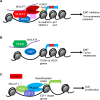The Oncogenic and Tumor Suppressive Functions of the Long Noncoding RNA MALAT1: An Emerging Controversy
- PMID: 32174966
- PMCID: PMC7056701
- DOI: 10.3389/fgene.2020.00093
The Oncogenic and Tumor Suppressive Functions of the Long Noncoding RNA MALAT1: An Emerging Controversy
Abstract
Long noncoding RNAs are recently emerging as critical factors of tumorigenesis. Originally regarded as a pre-messenger RNA (mRNA) splicing regulator, the long noncoding RNA MALAT1 has been demonstrated to regulate gene transcription by binding histone modification enzymes and transcription factors, and to regulate mRNA and protein expression post-transcriptionally by binding microRNAs (miRNAs) and acting as a sponge. Early studies consistently report that MALAT1 is up-regulated in human cancer tissues of various organ origins, particularly metastatic cancer tissues, that high levels of MALAT1 expression in cancer tissues are associated with poor patient prognosis, and that MALAT1 induces cancer cell proliferation, migration, and invasion in vitro and tumor metastasis in mice. By contrast, by analyzing multiple independent large datasets, MALAT1 have very recently been found to be down-regulated in human colorectal and breast cancer tissues, and low MALAT1 expression is associated with decreased patient survival. By binding to the transcription factor TEAD, MALAT1 suppresses metastasis gene expression, colorectal and breast cancer cell migration, invasion, and metastasis in vitro and in mice. MALAT1 has therefore been proposed to function as a tumor suppressor in colorectal and breast cancers. More comprehensive studies with multiple independent cohorts of human cancer tissues of various organ origins, in vitro and in vivo function, and mechanism studies with rescue experiments are required to confirm the oncogenic or tumor suppressive role of MALAT1 in other cancers.
Keywords: MALAT1; cell migration; gene expression; invasion; metastasis; pre-messenger RNA splicing; tumorigenesis.
Copyright © 2020 Chen, Zhu and Jin.
Figures

Similar articles
-
Aberrant KDM5B expression promotes aggressive breast cancer through MALAT1 overexpression and downregulation of hsa-miR-448.BMC Cancer. 2016 Feb 25;16:160. doi: 10.1186/s12885-016-2108-5. BMC Cancer. 2016. PMID: 26917489 Free PMC article.
-
MALAT1 promotes colorectal cancer cell proliferation/migration/invasion via PRKA kinase anchor protein 9.Biochim Biophys Acta. 2015 Jan;1852(1):166-74. doi: 10.1016/j.bbadis.2014.11.013. Epub 2014 Nov 18. Biochim Biophys Acta. 2015. PMID: 25446987 Free PMC article.
-
Long non-coding RNA MALAT1 regulates BLCAP mRNA expression through binding to miR-339-5p and promotes poor prognosis in breast cancer.Biosci Rep. 2019 Feb 15;39(2):BSR20181284. doi: 10.1042/BSR20181284. Print 2019 Feb 28. Biosci Rep. 2019. PMID: 30683807 Free PMC article.
-
New Insights into Long Non-Coding RNA MALAT1 in Cancer and Metastasis.Cancers (Basel). 2019 Feb 13;11(2):216. doi: 10.3390/cancers11020216. Cancers (Basel). 2019. PMID: 30781877 Free PMC article. Review.
-
MALAT1-related signaling pathways in colorectal cancer.Cancer Cell Int. 2022 Mar 19;22(1):126. doi: 10.1186/s12935-022-02540-y. Cancer Cell Int. 2022. PMID: 35305641 Free PMC article. Review.
Cited by
-
A Unique Spectrum of Spontaneous Tumors in Dino Knockout Mice Identifies Tissue-Specific Requirements for Tumor Suppression.Cells. 2022 Jun 2;11(11):1818. doi: 10.3390/cells11111818. Cells. 2022. PMID: 35681513 Free PMC article.
-
A cutting-edge immunomodulatory interlinkage between HOTAIR and MALAT1 in tumor-associated macrophages in breast cancer: A personalized immunotherapeutic approach.Front Mol Biosci. 2022 Oct 28;9:1032517. doi: 10.3389/fmolb.2022.1032517. eCollection 2022. Front Mol Biosci. 2022. PMID: 36387279 Free PMC article.
-
Role of MALAT1 in gynecological cancers: Pathologic and therapeutic aspects.Oncol Lett. 2021 Apr;21(4):333. doi: 10.3892/ol.2021.12594. Epub 2021 Feb 25. Oncol Lett. 2021. PMID: 33692865 Free PMC article. Review.
-
Comprehensive analysis of DRAIC and TP53TG1 in breast cancer luminal subtypes through the construction of lncRNAs regulatory model.Breast Cancer. 2022 Nov;29(6):1050-1066. doi: 10.1007/s12282-022-01385-7. Epub 2022 Jul 24. Breast Cancer. 2022. PMID: 35871431
-
CRISPR-Based Approaches for the High-Throughput Characterization of Long Non-Coding RNAs.Noncoding RNA. 2021 Dec 13;7(4):79. doi: 10.3390/ncrna7040079. Noncoding RNA. 2021. PMID: 34940760 Free PMC article. Review.
References
Publication types
LinkOut - more resources
Full Text Sources

